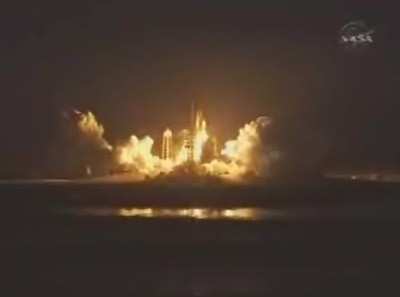Launch Lights Up The Florida Twilight Sky
ANN REALTIME UPDATE 03.15.09 1945 EDT: "Rock 'n
roll, Discovery!" That message of encouragement from launch control
came five seconds after the space shuttle Discovery cleared the
launch tower, heading into orbit on a mission to deliver the last
set of solar panels to the International Space Station.

Discovery rocketed off the pad at 1943 EDT, lighting the
twilight sky over NASA's Kennedy Space Center. This is the 125th
shuttle mission, and 36th for the oldest orbiter in NASA's shuttle
fleet.
The STS-119 crew will rendezvous with the ISS Tuesday.
Earlier Reports
1820 EDT: It looks like we're gonna light this
candle! The closeout crew has locked Discovery's hatch and is
getting ready to leave Launch Pad 39A at NASA's Kennedy Space
Center in Florida. The astronauts inside Discovery can open the
hatch quickly in an emergency, but the countdown is moving along
with no technical concerns.

The crew members are going through checklists and the launch
team is watching over the systems and subsystems of the shuttle as
launch time nears. Shuttle Weather Officer Kathy Winters has
upgraded the launch forecast to 100 percent "go" for the 7:43 pm
EDT liftoff of space shuttle Discovery.
The astronauts are strapped inside the shuttle, with four on the
flight deck and three on the lower level of the crew compartment.
Commander Lee Archambault and Pilot Tony Antonelli are seated in
the front seats surrounded by the instrument panels and windows
needed to control the shuttle. Steve Swanson will serve as flight
engineer during ascent, so he is sitting behind and between
Archambault and Antonelli. Joseph Acaba is in a seat behind
Antonelli where he, too, can help out during launch.
On the lower deck, Richard Arnold is closest to the hatch. John
Phillips is in the center seat and Japan's Koichi Wakata is in the
right-most seat. Sandra Magnus will sit in his place during
landing, after Wakata transfers to the International Space
Station.

During Discovery's 13-day mission, the STS-119 crew members will
deliver the S6 truss segment and install the final set of
power-generating solar arrays to the International Space Station.
The S6 truss will complete the backbone of the station and provide
one-fourth of the total power needed to support a crew of six.
1415 EDT: The clock is ticking towards the
scheduled launch of the space shuttle Discovery on its STS-119
mission to the International Space Station. NASA has completed the
three-hour process to fuel the external tank, and there are no
indications of the leak that scrubbed Wednesday's launch
attempt.

T-minus zero is scheduled for 1943 EDT Sunday night. At the
moment, the countdown clock has entered a planned hold at T-3
hours, and NASA says everything remains on schedule for the launch
of space shuttle Discovery.
The weather forecast calls for an 80 percent chance of
acceptable conditions at launch time, with negligible concern for
the potential for low cloud ceilings in the area.
As ANN reported, NASA discovered a potentially
catastrophic hydrogen leak while fueling the orbiter Wednesday
morning. The leak developed on the piping that runs from the fixed
service structure to a valve at the intertank section of the
shuttle's external tank. The pipe moves hydrogen gas away from the
shuttle and to a flare stack near the launch pad that burns it away
safely.
Originally scheduled to liftoff February 12, Discovery was
grounded for a month as NASA examined hydrogen flow control valves
linking the external tank to the orbiter. One of those valves was
found cracked after Endeavour returned from its mission in
November; NASA opted to swap the valves originally installed on
Discovery, with lower-time parts.
 ANN's Daily Aero-Linx (04.13.24)
ANN's Daily Aero-Linx (04.13.24) ANN's Daily Aero-Term (04.13.24): Beyond Visual Line Of Sight (BVLOS)
ANN's Daily Aero-Term (04.13.24): Beyond Visual Line Of Sight (BVLOS) Airborne 04.09.24: SnF24!, Piper-DeltaHawk!, Fisher Update, Junkers
Airborne 04.09.24: SnF24!, Piper-DeltaHawk!, Fisher Update, Junkers Aero-News: Quote of the Day (04.14.24)
Aero-News: Quote of the Day (04.14.24) ANN's Daily Aero-Term (04.14.24): Maximum Authorized Altitude
ANN's Daily Aero-Term (04.14.24): Maximum Authorized Altitude






